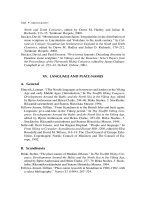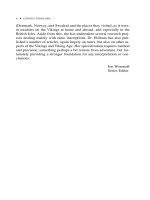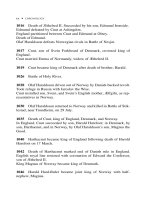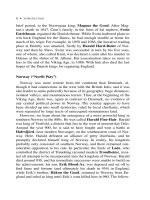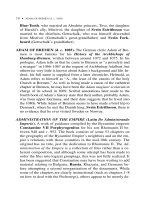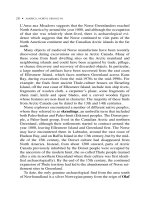- Trang chủ >>
- Khoa Học Tự Nhiên >>
- Vật lý
the a to z of mathematics, a basic guide - sidebotham
Bạn đang xem bản rút gọn của tài liệu. Xem và tải ngay bản đầy đủ của tài liệu tại đây (1.41 MB, 483 trang )
The A to Z of Mathematics
The A to Z of Mathematics
A Basic Guide
Thomas H. Sidebotham
St. Bede’s College
Christchurch, New Zealand
A JOHN WILEY & SONS, INC., PUBLICATION
This book is printed on acid-free paper.
∞
Copyright
C
2002 by John Wiley & Sons, Inc., New York. All rights reserved.
Published simultaneously in Canada.
No part of this publication may be reproduced, stored in a retrieval system or transmitted in any form
or by any means, electronic, mechanical, photocopying, recording, scanning or otherwise, except as
permitted under Sections 107 or 108 of the 1976 United States Copyright Act, without either the
prior written permission of the Publisher, or authorization through payment of the appropriate per-
copy fee to the Copyright Clearance Center, 222 Rosewood Drive, Danvers, MA 01923, (978) 750-
8400, fax (978) 750-4744. Requests to the Publisher for permission should be addressed to the
Permissions Department, John Wiley & Sons, Inc., 605 Third Avenue, New York, NY 10158-0012,
(212) 850-6011, fax (212) 850-6008, E-Mail:
For ordering and customer service, call 1-800-CALL-WILEY.
Library of Congress Cataloging-in-Publication Data is available
The A to Z of Mathematics : A Basic Guide—Thomas H. Sidebotham
ISBN 0-471-15045-2
Printed in the United States of America.
10987654321
To my wife, Patricia
Who persuaded me to get started and
supported me until it was finished
Contents
Preface ix
Acknowledgments xi
A 1
B 48
C 63
D 145
E 167
F 197
G 214
H 234
I 245
K 269
L 272
M 281
N 296
O 306
P 314
vii
viii CONTENTS
Q 358
R 371
S 399
T 433
U 463
V 464
W 471
X 472
Y 473
Z 474
Preface
Throughout the world many people suffer from the same problem: math anxiety. No
other area of skill seems to polarize people so readily into two contrasting groups,
those who can do math and those who cannot. Of the two groups, the second one is
by far the larger. To succeed in mathematics you need to understand the basics, and
only then can you learn with confidence. Many people fall at this first hurdle and then
struggle later. My aim in writing this book is to guide you through the basics so that
you can develop an understanding of mathematical processes. As you study this book
you will become aware of how mathematics relates to everyday life and situations
with which you are familiar. Study this book in depth, simply browse, or search for
the meaningof a word, andlearn yourmath again.Why shouldyou go to this trouble?
Whatever your age, mathematics is one of the basic requirements of life. This study
of mathematics will make a difference.
This book is written in an appropriate language for explaining basic mathematics
to the general reader, and uses examples drawn from everyday life. There are many
worked examples with detailed steps of working. Each step of working is accompa-
nied by an explanation. It is this process of showing HOW and explaining WHY that
gives this book its unique style. Those mathematical abbreviations that often frustrate
readers are written in full and the text is “user-friendly.” For quick reference the for-
mat of the book is alphabetical, and it covers topics in basic mathematics. They are
linked together with cross-references so that a theme can be followed through. This
book is a great deal more than a dictionary. Under each entry there is a straightfor-
ward explanation of the term, followed in many cases by carefully worked examples,
showing the relevance of mathematics in the world around us. At the end of some
entries the reader is directed to other references in the book if some prior knowledge
is needed. The mathematics is reliable and up to date, and encompasses a wide range
of topics so that everyone will find something of interest.
ix
x PREFACE
The material in the book falls into three categories.
1. There are processes that explain specific skills; a typical example is the entry
Algebra.
2. There are straightforward definitions of words with applications in the world
around us, as in the entry Proportion.
3. There is a variety of enrichment material that has good entertainment value,
like Hexomino.
I believe there is something of interest for everyone. If you are curious about
mathematics and it intrigues you, now may be the time to take the initiative and
discover that you indeed have skills in this area of knowledge. Some people need
the maturity of a few more years before they achieve success. If you are making a
career change and need to revise your mathematical knowledge, then this book is
for you. The book will appeal to everyone, even students, who may be interested in,
or need to catch up on, basic mathematics. If you are a parent who desires to help
your son or daughter and lack the expertise, then this book is for you also. The style
and presentation of the book are chosen specifically to suit the lay reader. It is a
useful resource for home schooling situations. I hope it is a rich source of ideas for
mathematics teachers and also those who are in teacher training, whatever subject in
which they are specializing.
You will need a scientific calculator to follow through the steps of working in
some of the examples. In statistical topics the reader is referred to the calculator
handbook for its use, because brands of calculators can vary so much. The whole
book is cross-referenced. If readers are not familiar with the explanations given in a
specific entry, they are advised to first read the references at the end of the entry to
prepare the groundwork. This book contains an abundance of diagrams, equations,
tables, graphs, and worked examples. An emphasis is placed on SI units throughout.
If you are keen to acquire the basic skills of mathematics in this book, I offer the
following advice. Do not read it like you may read a novel in which you can skim and
still enjoy the book and have a good grasp of the story and plot. To grasp mathematics
you must examine the detail of every word and symbol. Have a pen, a calculator, and
paper at hand to try out the processes and verify them for yourself.
It is my hope that this book will be on a bookshelf in every home, and will be
used by family members as a reference and guide. I am sure you will find it useful,
interesting, and entertaining.
Tom Sidebotham
Acknowledgments
I take this opportunity to thank the following persons, without whose help and
guidance this book would not have been possible: Steve Quigley, for encouraging,
enthusing, and redirecting me, and for sharing the vision; Heather Haselkorn, for all
her efforts on my behalf to keep the project afloat and for maintaining the lines of
communication; David Byatt, for scrutinizing the text and offering judicious alterna-
tives (the accuracy is entirely the responsibility of the author); Dr. David Sidebotham,
for his computer skills in enabling me to transplant the book in New York; Stephanie
Lentz and her team at TechBooks for transforming my manuscript so wonderfully
well; and lastly, the Angel at my elbow throughout the writing.
xi
A
ABSOLUTE VALUE
The absolute value of a number is the distance of the number from the origin 0,
measured along the number line. In the accompanying figure the absolute value of 3
at point B is the distance of point B from 0, which is 3. The absolute value of −2at
point A is the distance of point A from 0, which is 2.
−3 −2
−1
0 1 2 3
AB
4
The symbol for the absolute value of a number is two vertical parallel lines placed
around the number. At the point B, the absolute value of 3 is written as
|
point B −point 0
|
=|3 − 0|
=|3|
= 3
If the subtraction had taken place in the opposite way, the answer would still be 3,
but the working would be
Absolute value of 3 =
|
point 0 −point B
|
=
|
0 − 3
|
=
|
−3
|
= 3 as before
Similarly for the point A:
Absolute value of −2 =
|
point A − point 0
|
=
|
−2 − 0
|
=
|
−2
|
= 2
1
The A to Z of Mathematics: A Basic Guide.
Thomas H. Sidebotham
Copyright
¶ 2002 John Wiley & Sons, Inc.
ISBN: 0-471-15045-2
2 ABSTRACT
The absolute value of the line segment AB is obtained in the following way:
Absolute value of AB =
|
point A − point B
|
or
|
point B − point A
|
=
|
−2 − 3
|
=
|
−5
|
= 5
When an absolute value is applied to a subtraction, it is safe to subtract the two
numbers on the number line in either direction; one gets the same answer for the
length of the line segment that joins them.
References: Integers, Number Line.
ABSTRACT
“Abstract” means separated from practical problems in the real world. Mathematics
is an abstract subject and is practiced using symbols, but these symbols can represent
real-life things. Real problems can be solved using abstract mathematics, and then
the symbols used can be related back to solve the practical problem. In the example
that follows the practical problem is about finding the width of a lawn. In the ab-
stract, the symbol representing this width is x. The value of x is found using abstract
mathematics, and so the width of the lawn is known and the problem solved.
Example. Andrew has 24 square meters of ready-made lawn and plans to lay it in
his garden. His wife, Jo, suggests that a good shape is a rectangle that is twice as long
as it is wide. What width should Andrew make the lawn?
Solution. This is a real-life problem, but it can be solved using abstract symbols
in the following way: Let the width of the lawn be x meters; its length will be 2x,
because its length is twice its width (see the figure): The calculation goes as follows:
2
x
x
LAWN
Area of rectangle = length × width
24 = 2x × x This is an abstract equation
24 = 2x
2
Multiplying the terms on the right-hand
side
12 = x
2
Dividing both sides of the equation by 2
ACCELERATION 3
√
12 = x Taking the square root of both sides of the equation
x = 3.464 Using a calculator for the square root
Now relate the abstract symbol x back to the real-life situation. The width of the lawn
is 3.46 meters (three significant figures).
References: Accuracy, Konigsberg Bridge Problem, Square Root.
ACCELERATION
If a car is increasing its velocity, for example, upon changing lanes on a freeway, its
acceleration is the rate at which its velocity is changing with respect to time. The
SI unit of acceleration is meters per second per second, which is abbreviated m s
−2
or m/s
2
. Another unit of acceleration is centimeters per second per second, which is
abbreviated cm s
−2
or cm/s
2
.
As a body falls to earth it has an acceleration due to gravity that is approximately
10ms
−2
, and this acceleration is afixedvalue at differentplaces on the earth’s surface.
This means that when a stone is falling through the air, its velocity increases by
10ms
−1
for every second it is falling. In this example we ignore the air resistance.
Suppose the velocity of the stone is measured every second and recorded in a table
as follows:
Time t ins 0123
Velocity v inms
−1
0102030
The values from the table are written as ordered pairs and then plotted to draw a
velocity–time graph (see figure a). In this case the ordered pairs are (0, 0), (1, 10),
(2, 20), and (3, 30).
10
20
30
0
123
v
t
(a)
m s
−1
seconds
The slope of this graph =
rise
run
Formula for slope
=
30 m/s
3s
= 10ms
−2
The acceleration of the stone is 10 m s
−2
.
4 ACCELERATION
The slope of a velocity–time graph gives the acceleration. If the stone is thrown
upward, the velocity is decreasing, and the negative acceleration is called retardation.
When the acceleration is not a fixed quantity, but varies, the velocity–time graph is
a curve. This is the situation, for example, for a motorcyclist who accelerates from a
standing position.
Example. A motorcyclist isaccelerating from astanding position, andthe velocities
inms
−1
are recorded every 10 seconds. This information is shown in the table. The
velocity of the cyclist can be expressed by the formula v = 0.03 t
2
. Find the accelera-
tion of the cyclist when the time is 20 seconds.
Time in seconds 0 10 20 30
Velocity in m s
−1
0 3 12 27
Solution. Using the data in the table, we draw the velocity–time graph (see figure b).
The acceleration of the motorcyclist is changing, which is indicated by the curved
graph. To find the acceleration at t = 20 seconds, we find the slope of the curve at the
point on the graph where t is 20 seconds, and this slope gives the acceleration at that
instant. The slope of the curve is the slope of the tangent to the curve at that point.
Using a ruler, we draw a tangent as accurately as possible at the point on the curve
wheret = 20seconds. The tangent should just touch the curve at this point. The length
of the tangent is not critical, but should not be too short, otherwise accuracy will be
lost. The slope of this tangent will give the acceleration of the cyclist at 20 seconds.
Complete the right-angled triangle, and estimate the rise and the run, but take care
with the units:
Slope of tangent =
rise
run
=
22 m/s
20 seconds
= 1.1ms
−2
Rise
Run
t
5
10
15
20
25
30
35
0
10
20 30
v
(b)
m s
−1
seconds
ACCURACY 5
The acceleration of the cyclist at the time when t = 20 seconds is estimated to be
1.1ms
−2
.
References: Ordered Pairs, Retardation, SI Units, Slope, Tangent, Velocity, Velocity–Time
Graph.
ACCURACY
When the dimensions of a quantity are measured, such as the height of a building, the
resulting measurement cannot be exact, because of the limitations of the measuring
instrument. The measurement is approximate, and is given to a degree of accuracy
in the form of decimal places (dp), significant figures (sf), or the nearest whole unit.
Whenever measurements are made or calculations done using measured quantities,
the degree of accuracy shouldalways be statedwith the answer. Thisprocess of giving
an answer in approximate form is called rounding.
One dayDavid was listeningto the radio when he heard the news of an earthquake.
He heard that its centerwas 50 kilometersbelow the surface of the earth. Later, he was
discussing the earthquake at home; Jane had heard on the radio that the center was
48 kilometers below ground andWilliam saidit was 47.4 kilometersunderground. All
three measurements are correct, but differ because were rounded to different degrees
of accuracy by the three different radio stations.
r
David’s measurement of 50 km had been rounded to one significant figure.
r
Jane’s measurement of 48 km had been rounded to two significant figures.
r
William’s measurementof 47.4km had been rounded tothree significant figures.
Numbers are rounded in order to supply different people with the kind of informa-
tion they require. For example, suppose a journalist was told that the attendance for
the final ofthe 100 metersrace at theOlympicGames was 95,287 people.In his report
he would probably round the figure to the nearest thousand, because readers would
not be interested in the exact figure. In his article he would write up the attendance as
95,000. The organizers of the games, who are interested in the receipts, would prefer
a more exact figure of 95,290, which is rounded to the nearest 10 people.
Suppose the length of a small room is measured to be 3.472 meters. This measure-
ment can be rounded to different degrees of accuracy:
3.47 m (2 dp) Showing two decimal places
3.5 m (1 dp) Showing one decimal place
3.0 m (2 sf) Showing two figures
The zero must be inserted, otherwise one figure would be showing:
3 m (1 sf) Showing one figure
6 ACCURACY
The method used in rounding numbers to a given number of decimal places is illus-
trated in the following examples.
Example 1. Suppose we are rounding the number 3.47 to 1 dp, which means that
only one number is written after the decimal point. We round up to 3.5 and not down
to 3.4, because 3.47 is closer to 3.5 than it is to 3.4 (see figure a).
3
.
4
3
.
5
3
.4
7
(
a
)
Example 2. Round the number 3.423 to 2 dp. In this example we write the answer
with two numbers written after the decimal point. The number 3.423 rounds down to
3.42, because it is closer to 3.42 than it is to 3.43 (see figure b).
3
.4
2
3
.42
3
(
b
)
3
.4
3
Example 3. Write 3.45 to 1 dp. For a number like 3.45, which is exactly halfway
between 3.4 and 3.5, we always round up to the higher value, which in this example
means we round to 3.5 (see figure c).
3
.
4
3
.
5
3
.4
5
(
c
)
The examples above illustrate rounding numbers to a specific number of decimal
places.Rounding numbers to significant figures works in a similar way. The difference
is thatfigures are counted irrespective of theposition ofthe decimalpoint. Sometimes
zero is not included in the count of significant figures. This will be explained in some
of the following examples.
Example 4. Round 20.8 to two significant figures. The number 20.8 rounds up to
21, because it is closer to 21 than it is to 20 (see figure d).
2
0
21
2
0
.
8
(
d
)
Example 5. Round 0.35 to one significant figure. The number 0.35 rounds up to
0.4, because 0.35 is exactly halfway between 0.3 and 0.4 (see figure e). Note that
we write a zero to show there is no whole number, but this zero does not count as a
significant figure.
ACRE 7
0
.
3
0
.4
0
.
35
(
e
)
Example 6. Round 8.032 to 3 sf. The number 8.032 rounds down to 8.03, because
it is closer to 8.03 than it is to 8.04 (see figure f). Note that zero counts as a significant
figure when it acts as a placeholder between other figures.
(
f
)
8
.
03
8
.
032
8
.
04
Example 7. Write 0.6049 to 2 sf. The number 0.6049 rounds down to 0.60, because
it is closer to 0.60 than it is to 0.61 (see figure g). This example shows that when
rounding to 2 sf we only examine the third figure, which is 4, and ignore the 9, which
does not affect the second significant figure. Note also that the zero in the answer
must be inserted to show the required number of two figures.
0
.6
0
0
.604
9
(g)
0
.6
1
Example 8. Round off 208 to 2 sf. The number 208 rounds up to 210, because it is
closer to 210 than it is to 200 (see figure h). This is an interesting example, because
we cannot write 21 as the answer. It has the required two figures, but 21 is not roughly
the same size as 208. So a zero must be inserted to make sure the answer of 210 is
approximately the same size as 208. Alternatively, the answer can be expressed in
standard form as 2.1 × 10
2
, which is rounded to 2 sf.
(
h
)
2
00
2
08
21
0
References: Approximation, Decimal, Limits of Accuracy, Standard Form.
ACRE
The acre is a unit of area for measuring the size of a piece of land, and is an imperial
unit. One acre is 4840 square yards, or 43,560 square feet. Historically, the acre was
defined to be the amount of land that a team of two oxen could plough in 1 day. One
acre is approximately 0.40 hectare, or 1 hectare is about 2.47 acres.
For practical purposes, 1 hectare is roughly 2
1
2
acres, or 5 acres is approximately
2 hectares.
Reference: Hectare, Imperial System of Units, SI Units.
8 ACUTE ANGLE
ACUTE ANGLE
This entry also discusses right angle, straight angle, obtuse angle, and reflex angle.
In order to define acute angles it is first necessary toexplain a right angle.An angle of
90 degrees, which is written as 90
◦
, is called a right angle. A right angle is indicated
in the following diagrams by a box, and represents a quarter turn. A flagpole makes
a right angle with the ground (see figure a).
Right
angle box
(a)
(b)
Angles that are less than one right angle, that is, less than 90
◦
, are called acute
angles. If the lid of a box is opened through an acute angle and then let go, the lid
will fall back onto the top of the box (see figure b).
Every triangle must have at least two acute angles (see figure c).
(c)
12
3
6
9
(
d
)
An angle of 180
◦
is called a straight angle and corresponds to a half turn.
On a clock face when the time is 6 o’clock, the angle between the two hands is a
straight angle (see figure d).
An obtuse angle is greater than 90
◦
, but less than 180
◦
. Ifthe lid on a box is opened
through an obtuse angle and let go, it will fall open and not fall back onto the top of
the box (see figure e).
(e)
(f)
The trapezium shown in figure f has two obtuse angles.
ADJACENT ANGLES 9
A reflex angle is greater than 180
◦
, but less than 360
◦
. An example of a reflex
angle is a three-quarters turn. When the lid of a box is opened fully, the lid has turned
through a reflex angle (see figure g).
(g)
(h)
When a quadrilateral contains a reflex angle, it is called a reentrant quadrilateral
(see figure h).
ADDEND
Numbers that are added together are called addends. The answer obtained from their
addition is called the sum:
Addend + addend = sum
More than two addends might be involved. For example, to get the sum of 3 + 9 +6;
we add together the pair ofnumbers3and9toget 12, and then add the12to6toget18.
Or, in adding numbers in our head, we might develop the skill of first arranging them
into pairs that add tomake 10, becauseit is easyto addnumbers onto 10.For example,
7 + 8 = 7 + (3 + 5) Splitting 8 up into 3 + 5
= (7 + 3) +5 Combining the 7 with the 3 to make 10
= 15
Reference: Associative Law.
ADJACENT ANGLES
Angles such as x and y in figure a that lie side by side are called adjacent angles.
(a)
x
y
a
b
(b)
10 ALGEBRA
Any number of adjacent angles that form a straight line add up to 180
◦
. When two
adjacent angles form a straight line they add up to 180
◦
.Infigure b, angles a and b
are supplementary angles:
a + b = 180
◦
Example 1. If a spade makes an acute angle of 76
◦
with the horizontal ground, find
the obtuse angle that the spade makes with the ground.
Solution. Let this obtuse angle be x (see figure c):
(
c
)
x
7
6
°
x + 76
◦
= 180
◦
Sum of adjacent angles = 180
◦
x = 104
◦
Subtracting 76
◦
from both sides of the equation to solve it
The spade makes an obtuse angle of 104
◦
with the ground.
Example 2. Light rays are reflected from a mirror as shown in figure d. Find the
angle x between the two rays.
x
(d)
35
°
35
°
Solution. The calculation goes as follows:
35
◦
+ x + 35
◦
= 180
◦
Sum of adjacent angles = 180
◦
x + 70
◦
= 180
◦
Simplifying
x = 110
◦
Subtracting 70
◦
from both sides of the equation to
solve it
Reference: Geometry Theorems.
ALGEBRA
Algebra is the abstract studyof the propertiesof numbers,using letters tostand for the
numbers; these lettersarecalled variables.Variables stand forunknown quantities and
ALGEBRA 11
we use the operations of arithmetic to try to find their value. This entry explains how
to simplify, or rewrite, expressions by adding, subtracting, multiplying, and dividing
terms.
Example 1. Bill is doing a preliminary sketch of the ground floor of a house he is
designing. He is not sure of some of the dimensions and uses variables x and y to
represent them. All measurements are in meters. His sketch is shown in figure a, and
is not to scale. Find the perimeter of the house.
Solution. The perimeter is the distance all the way around the house:
Perimeter = x + 3y + 8 + y + 18 + 3x
Perimeter = x + 3x + 3y + y + 8 + 18 Grouping similar terms together
Perimeter = 4x + 4y + 26 meters Adding similar terms together.
This expression for the perimeter cannot be simplified further.
x
3
y
8
y
18
(a)
3
x
When terms are similar andcan be simplifiedby addingor subtracting, wesay they
are “like terms.” The process ofadding andsubtracting like terms is called “collecting
terms.” Terms are like terms if they are exactly the same except for the number in
front of them. This number written in front of the term is called the coefficient of the
term. For example, the coefficient of y in the term −3y is −3.
Examples of sets of like terms are (i) 2a, 4a, −6a, 24a; (ii) xy, 3xy, 5xy, −14xy;
(iii) 4x
2
, x
2
, 2x
2
, −16x
2
.
Example 2. Simplify these expressions: (i) −2xy + 4xy − 3xy, (ii) a + 2b −
2a + ab.
Solution. For part (i)
−2xy+ 4xy − 3xy =−1xy The terms are all like terms, and calculating − 2 +
4 − 3 =−1 gives the coefficient of xy
=−xy When the coefficient of a term is 1or−1, it is not
written with the term
12 ALGEBRA
For part (ii)
a + 2b − 2a + ab = a − 2a + 2b + ab Grouping the like terms together
=−a + 2b + ab There are no more like terms
Example 3. Now find the area of the house.
Solution. To find the area of the ground floor of the house, we need to divide
the shape up into two rectangles, find the area of each, and add them together (see
figure b):
3
y
8
18
3
x
(b)
x
y
Area of larger rectangle = length ×width
= 3x × x
= 3x
2
square meters x
2
is shorthand for x × x
Area of the smaller rectangle = length × width
= 8 × y
= 8y square meters 8y is shorthand for8 × y
Total area of the house = sum of areas of the two rectangles
= 3x
2
+ 8y
This expression cannot be simplified, because the two terms are not like terms.
In the example of finding the area of the house we multiplied terms together. We
now study some more examples that explain how to simplify expressions when terms
are multiplied.
If the length and width of a square are x, then
Area of a square = length × width
A = x · x The dot may be used for “times”
A = x
2
In words we say “x squared”
ALGEBRAIC FRACTIONS 13
If the length, width, and height of a cube are all x, then
Volume of a cube = length × width × height
V = x · x · x
V = x
3
In words we say “x cubed”
Example 4. Simplify these expressions: (i) 2 × 3x, (ii) 2ab ×4b
Solution. For part (i)
2 × 3x = 2 ×3 × x Inserting the × sign between 3 and x
= 6 × x Multiplying the numbers 2 and 3 first
= 6x Writing without the × sign
For part (ii)
2ab ×4b = 2 ·a · b · 4 · b Inserting dots for the × signs
= 2 · 4 ·a · b · b Grouping terms in alphabetical order with numbers
first.
= 8 ·a · b
2
b · b = b
2
= 8ab
2
The process of dividing algebraic terms and simplifying the answer, is explained
under the entry Canceling.
References: Abstract, Algebraic Equations, Coefficient, Equations, Factor, Indices, Substitu-
tion, Variable.
ALGEBRAIC EQUATIONS
References: Balancing an Equation, Equations, Linear Equation, Quadratic Equations, Simul-
taneous Equations, Solving an Equation.
ALGEBRAIC FRACTIONS
Algebraic fractions, like arithmetic fractions, can be canceled, added, subtracted,
multiplied, and divided. Canceling fractions is explained under the entry Canceling.
It may be helpful to realize that if two fractions are equivalent, they can be written
differently, as demonstrated here.
When the variable y is multiplied by the fraction
1
5
the result is
1
5
y. Also, when
5 divides y, the result is written as
y
5
.
14 ALGEBRAIC FRACTIONS
Since multiplying by
1
5
achieves the same result as dividing by 5, it follows that
1
5
y and
y
5
are equivalent. Similarly,
2
3
x and
2x
3
are equivalent.
In order to add and subtract fractions they must have the same denominator. For
example,
x
7
+
y
7
=
x + y
7
The two fractions have the same denominator, 7
If the denominators are not the same, each fraction has to be converted to an
equivalent fraction so that the denominators are the same size.
Example. Simplify
x
5
+
2x
3
Solution. The two denominators are 5 and 3. The lowest common multiple of 5 and
3 is the lowest positive number they both divide into exactly, which is 15. When
working with fractions the lowest common multiple is called the lowest common
denominator. Each fraction is thenwritten with a denominator of 15, using equivalent
fractions, as set out here:
x
5
×
3
3
=
3x
15
and
2x
3
×
5
5
=
10x
15
Now,
x
5
+
2x
3
=
3x
15
+
10x
15
Replacing each fraction in the sum by its equivalent
fraction
=
3x + 10x
15
The denominators are the same and numerators are
added
=
13x
15
Which is a single fraction
Example. Simplify this expression
2
x
2
−
3
xy
by subtracting the two fractions.
ALGEBRAIC FRACTIONS 15
Solution. The denominators are x
2
and xy. The lowest common multiple of x
2
and
xy is x
2
y. Thus
2
x
2
−
3
xy
=
2
x
2
×
y
y
−
3
xy
×
x
x
Replacing each fraction by its equivalent
fraction
=
2y
x
2
y
−
3x
x
2
y
Simplifying each fraction
=
2y − 3x
x
2
y
The denominators are the same and fractions
are subtracted
Two fractions can be multiplied to obtain a single fraction. The numerators are
multiplied together, and the denominators are multiplied together.
Example. Simplify
2x
3
×
5x
4
Solution. Write
2x
3
×
5x
4
=
2x × 5x
3 × 4
=
10x
2
12
=
5x
2
6
×
2
2
2 is a common factor of numerator and denominator
=
5x
2
6
Canceling the 2’s
Two fractions can be divided to obtain a single fraction. The method is explained
in the following example.
Example. Simplify
3x
2
÷
1
2y
by dividing the fractions.
16 ALGEBRAIC FRACTIONS
Solution. Write
3x
2
÷
1
2y
=
3x
2
×
2y
1
Instead of dividing, multiply by the reciprocal of the
second fraction
=
6xy
2
Multiplying the numerators and denominators
=
3xy
1
×
2
2
2 is a common factor
= 3xy Canceling the 2’s
Example. On his way towork, in thecar, David reckons hisspeed through thetraffic
is 30 kilometers per hour, abbreviated km h
−1
, whereas for the return journey it is
40 km h
−1
. Calculate his average speed.
Solution.
Average speed =
total distance traveled
total time taken
Formula for average speed
Let the distance to work be x kilometers. Therefore the total distance traveled is
2x kilometers. On the outward journey the time taken is T
1
hours and for the return
journey the time is T
2
hours. Write
T
1
=
x
30
and T
2
=
x
40
The formula used is time = distance ÷ speed.
Now write
Total time = T
1
+ T
2
=
x
30
+
x
40
=
x
30
×
4
4
+
x
40
×
3
3
The lowest common denominator is 120
=
4x
120
+
3x
120
Simplifying each fraction
=
7x
120
Adding fractions with equal denominators



